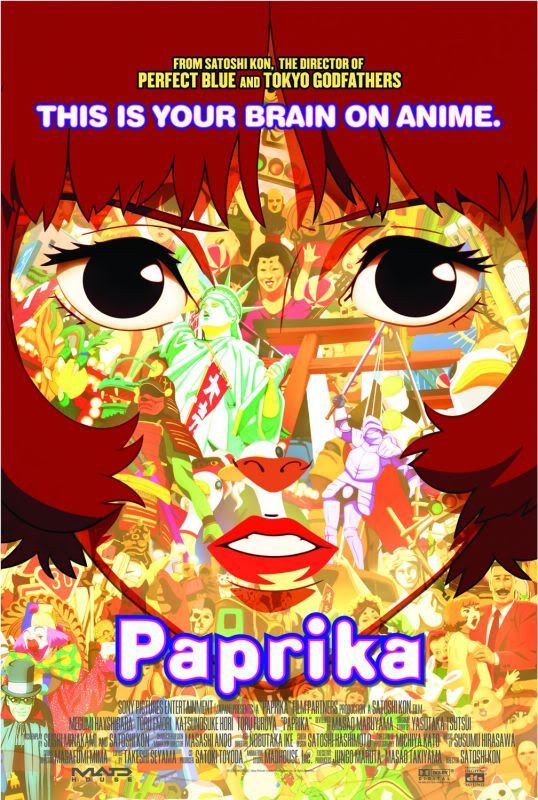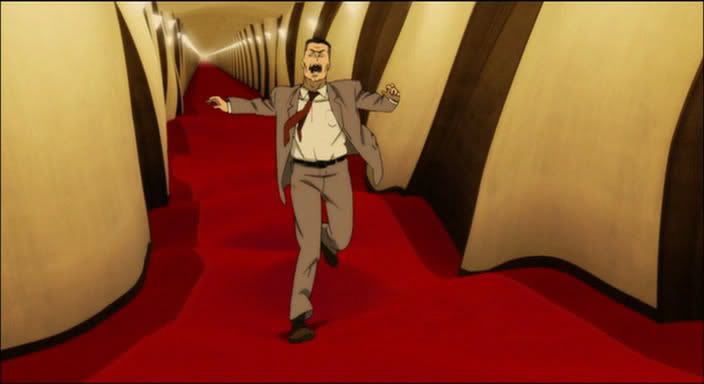 |
| Fig. 1 Paprika Poster. |
Satoshi Kon's
Paprika is a mind-melting dream-like animation that is much more of an experience than an exploration in narrative. It is vibrant and thrilling with a fantastic soundtrack to support its very strange but wonderful visuals.
Paprika is only Kon's fourth feature length animation, but it is clear from the fantastical visuals that he is very talented at timing and creating atmosphere, whether it is an unsettling or dream-like one. Mark W. MacWilliams explains that "
Kon worked under Akira creator Katsuhiro Otomo...In fact, it was Otomo who recommended Kon as the director of Perfecmact Blue [Perfect Blue]. Kon has gone on to direct other critically acclaimed films, most recently, Papurika (Paprika, 2006)" (MacWilliams, 2008:58)
Perfect Blue, an animated crime thriller, was Kon's directorial debut. The fact that Katsuhiro Otomo, a very successful director and writer himself, recommended Kon for the job is a big suggestion about how good he was, and his films since have been just as powerful whether for their visuals or narrative.
 |
| Fig. 2 Warped dream hallway. |
The central theme in
Paprika is the use of dreams as a vehicle into the minds of others. A new machine has been invented that allows for the wearer's dreams to be recorded onto a computer and watched back. This leads to the machine gaining too much power and, with sinister help, unleashing dreams into reality. Frenchy Lunning expressed that "
Paprika reinvents
some well-known concepts— that dreams are windows into other realities
and have great power, that the boundaries of self are not set by
consensus reality, that troubles stew in the worlds revealed by dreams,
and that dreams can be accessed like playing a DVD with the
bio-psycho-electronic DC-Mini machine in the film." (Lunning, 2009: 326) Dreams have always been considered significant when it comes to understanding the subconscious mind. Although some believe them to be just jumbles of thoughts from the previous day, others consider them to be revealing of the person's inner desires. To see a dream in the real world would allow the viewer to glance through a window into the dreamer's reality while they are sleeping. To then put this onto a DVD and watch it back combines the ethereal dream realm with a harsh mechanical reality that leads to a much more convoluted and unpredictable reality. It is this convoluted reality that was caused by the twisted desires of the films villain. As MacWilliams divulged, that Paprika is "
a disturbing science fiction feature film about the possibilities of psycho-terrorism." (MacWilliams, 2008:275) The film's villain, a crippled old man that desires power, wants nothing more than to take control of the world around him by removing all light and spreading his warped nightmarish darkness into the world.
 |
| Fig. 3 Dr. Chiba and her alter-ego Paprika. |
The dreams in
Paprika seem completely random to the audience. Without any further examination they resemble a random collection of toys, household furniture and objects dancing around in a parade-like fashion. However, when Lunning believes that "
Dreams are a playground of primal needs, emotions, fears, and desires." (Lunning, 2009: 327) these seemingly random objects can be interpreted as having much deeper meanings. One scene that is significant is when the central character, Dr. Chiba, confronts the villain of the film. Lunning continues that
"Of these, [desires] what the Freudians call “oral needs” are basic... in the crucial scene of the film, she/they cheerfully devours the now immense bad guy, Chairman— all of him— in one hugely hungry moment of pure incorporative appetite." (Lunning, 2009: 327) Dr.Chiba, now combined with her alter-ego Paprika, take 3 huge gulps of the Chairman and swallow him and all of his dark energy up completely. After every large gulp they age a decade or so, starting as a small adolescent child that develops into a grown woman with the final swallow of the chairman. Though the defeat of the chairman and the complete destruction of his nightmarish rein is the main focus, the swallowing of him is also significant. Sigmund Freud believed that there are several stages in a child's development, Nick Rennison explained that "
Each stage is characterised by the particular ways in which the child gains sexual pleasure. The first stage is the ‘oral stage’ in which the emphasis is, as the name makes clear, on the mouth." (Rennison, 2001:35) This 'oral stage' is characterised in adults by a need to enjoy things orally, such as smoking or eating. In this scene Dr. Chiba develops physically through her eating of the chairman. She begins as a baby with the desire to consume through her mouth, and through the consumption she develops physically into a satisfied woman.
Paprika was thoroughly enjoyable and as Lunning puts it: "
Kon’s film is a delightful fantasy/allegory about consensus reality versus freedom and creativity. In the end art and freedom win, and the film feels like springtime." (Lunning, 2009: 328) It was a glorious visual treat that revels in the colour, movement and chaos it portrays. It is a shame that Satoshi Kon will not be able to direct anymore films but with one more on the way it will hopefully be as energetic as the rest.
List of Illustrations
Figure 1. Paprika (2006) Paprika
poster. At: http://www.impawards.com/2006/posters/paprika_xlg.jpg (Accessed on: 22.02.12)
Figure 2. Paprika (2006)
Warped dream hallway. At: http://img406.imageshack.us/img406/1511/paprika2006dvdripxvidac.jpg (Accessed on: 22.02.12)
Figure 3. Paprika (2006)
Dr. Chiba and her alter-ego Paprika.. At: http://animemovieguide.com/wp-content/uploads/2011/03/paprika.jpg (Accessed on: 22.02.12)
Bibliography
Lunning, Frenchy (2009)
Mechademia 4. USA: University of Minnesota Press.
MacWilliams, Mark W. (2008)
Japanese Visual Culture : Explorations in the World of Manga and Anime. USA: M.E. Sharpe, Inc.
Rennison, Nick (2001)
Sigmund Freud. GBR: Pocket Essentials.





No comments:
Post a Comment